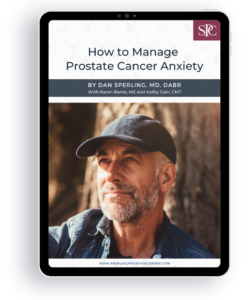The quote, “Aging is not for sissies,” is attributed to actress Bette Davis but no doubt millions of senior citizens can easily get on board with that sentiment. After age 65, chances of disease and accidents begin to increase, including chronic disease (diabetes, heart disease, cancer, stroke are the most common), falling, depression, anxiety, dementia and gradually failing senses and systems. Yikes!
Prostate cancer after age 70
It now looks like there’s another age-related threat for men over age 70: prostate cancer (PCa). A recent paper out of Cleveland Clinic analyzed the diagnostic and follow-up records of 2018 prostatectomy patients older than 70.[i] The research team collected data (from 2000-2011) on patients’ preoperative clinical factors, extraprostatic extension (PCa beyond the margin), and postoperative features (based on the gland specimens). They then calculated the statistical association between these factors and biochemical failure (rising PSA after surgery). For comparison, they did a parallel analysis of matched patients ages 50-70 with similar PCa features to determine the effect of age on treatment failure.
Findings
It’s noteworthy that among those >70 there was quite a discrepancy between their biopsy Gleason score vs. the post-prostatectomy Gleason score (pathology of gland specimens) as the following table shows:
| % of men at biopsy | % of men after surgery | |
| Gleason 6 | 35.8% | 10.1% |
| Gleason 7 | 45.9% | 63.3% |
| Gleason ≥8 | 18.3% | 26.6% |
Clearly, before surgery the biopsy picture was somewhat rosier than the actual pathology after surgery. It’s not surprising; we know that standard TRUS biopsy frequently misses clinically significant PCa; in this case, 90% of the patients were found to have less favorable disease AFTER surgery–not good news.
Likewise, before surgery (based on biopsy and digital rectal exam) the records showed that 74.1% had clinical stage T1 (PCa contained in the gland). However, after surgery 45.9% had stage pT3 (evidence of extraprostatic extension). Could the surgeons have known this sooner? By correlating pre-operative clinical factors with surgery results, the authors determined that the best predictors of extracapsular extension (stage pT3) were D’Amico risk factors, the number of positive biopsy cores, the maximum percentage of PCa per core, and PSA density at the time of biopsy. In other words, the clues were there.
In terms of treatment failure, biochemical recurrence occurred in 14.0% of the patients during the follow up period. The preoperative diagnostic factors that correlated predictively with treatment failure were higher primary Gleason pattern at biopsy, clinical stage, and PSA density, while the postoperative predictive factors were high prostatectomy Gleason score, positive margins, and stage pT3, with margin status and pT3 being the strongest predictors of failure.
Conclusion
To summarize, the team found that in prostatectomy patients older than 70, the surgical specimens show PCa with adverse features. The authors calculated that patients >70-year-old have 85% higher odds of biochemical recurrence than younger men with similar clinical factors at the time of diagnosis.
Preventing the fear factor
I have written many blogs on lifestyle factors that experts consider worthwhile for reducing PCa risk: diet, exercise, stress management, and a supportive social network with positive family/friend relationships. In fact, an interesting longevity study demonstrated that modifiable lifestyle factors can help men over age 70 live to an even riper old age with good health.
The 2008 study was titled “Exceptional longevity in men: modifiable factors associated with survival and function to age 90 years.” The research team used data from the Physicians’ Health Study (1981-2006).[ii] These were records on 2357 healthy men, average age 72 at the time of their enrollment. Based on their baseline physical health and lifestyle compared with their self-report and medical records 16 years later, 41% survived to at least age 90! The study showed that
… a 70-year-old man has a 54% chance of reaching the age of 90 if he does not smoke or have diabetes, has healthy weight and blood pressure, and exercises. But cutting out exercise and becoming more sedentary reduces the chances of reaching 90 to 44%. The chances dropped further with high blood pressure (36%), obesity (26%) and smoking (22%). Any three of these cut the chances of living to 90 to 14%.[iii]
The moral of the story? Take charge of your health well before you turn 70, and then stick with it. It may not guarantee that you avoid a chronic disease, falling, mental problems–or prostate cancer. But science shows that men who become wellness warriors have good reason to age fearlessly.
Download Our Free Ebook: “How to Manage Prostate Cancer Anxiety”

Don’t let anxiety over prostate cancer run you. Instead, learn how you can take charge and empower yourself to manage stress and boost positive treatment outcomes with our “first aid kit” of practical tips and tools.
NOTE: This content is solely for purposes of information and does not substitute for diagnostic or medical advice. Talk to your doctor if you are experiencing pelvic pain, or have any other health concerns or questions of a personal medical nature.
References
[i] Ko J, Falzarano SM, Walker E, Streator S et al. Prostate cancer patients older than 70 years treated by radical prostatectomy have higher biochemical recurrence rate than their matched younger counterpart. Prostate. 2013 Jun;73(8):897-903.
[ii] Yates LB, Djoussé L, Kurth T, Buring JE, Gaziano JM. Exceptional longevity in men: modifiable factors associated with survival and function to age 90 years. Arch Intern Med. 2008 Feb 11;168(3):284-90.
[iii] “Key to longer life may like in keeping fit from the age of 70, says study.” The Guardian, Feb. 12, 2008. https://www.theguardian.com/science/2008/feb/12/medicalresearch.longtermcare


